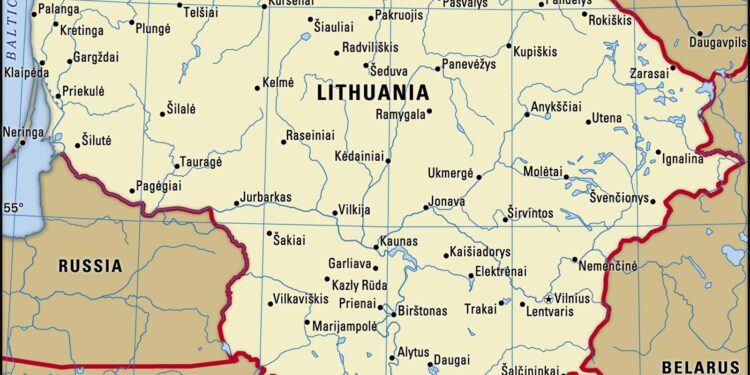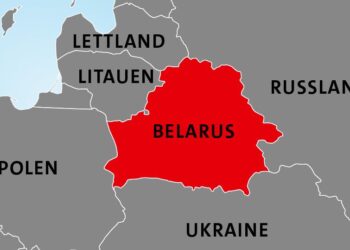Lithuania has announced a decisive escalation in its response to repeated disruptions at its airport, unveiling plans to close its border with Belarus and authorizing the use of force against unidentified balloons crossing from Belarusian airspace. The Baltic nation’s measures come amid growing tensions with its eastern neighbor, which Lithuania accuses of orchestrating a series of provocations that have repeatedly shut down its main airport. The developments mark a significant intensification in regional security concerns and raise questions about the future of Lithuania-Belarus relations.
Lithuania Implements Strict Measures to Secure Border Amid Heightened Tensions
In response to escalating tensions along its eastern frontier, Lithuania has announced a series of stringent security protocols to control movements and threats emanating from Belarus. The government declared the temporary closure of the Belarus border, a move described as necessary to prevent further destabilization and to reinforce national sovereignty. In a bold new directive, Lithuanian defense forces have been authorized to shoot down unidentified aerial objects, specifically targeting the numerous balloons that have disrupted air traffic and triggered multiple airport shutdowns across the nation.
- Full closure of the Lithuanian-Belarus border until further notice;
- Authorization for military interception of suspicious airborne devices, including drones and balloons;
- Increased patrols and surveillance to monitor cross-border activities;
- Coordination with EU agencies to manage airspace security and share intelligence.
| Measure | Details | Effectiveness Target |
|---|---|---|
| Border Closure | Complete halt on border crossings | Prevent illegal entry and trafficking |
| Balloon Neutralization | Authorization to shoot down aerial objects | Reduce airport disruptions |
| Enhanced Surveillance | Deployment of new radar systems | Early threat detection |
| EU Collaboration | Joint security operations | Regional stability |
Impact of Belarusian Balloon Incursions on Regional Aviation and Security
The repeated incursion of Belarusian balloons into Lithuanian airspace has ignited significant concerns across the Baltic region, severely disrupting civilian and commercial aviation operations. Multiple airport shutdowns have been recorded as authorities scramble to manage the unexpected threats these aerial devices pose. The balloons, suspected to be surveillance tools or provocations, have forced immediate suspensions of flights, leading to cascading delays across international and regional air traffic. As a result, airlines have recalibrated routes, sparking economic repercussions not only for Lithuania but for neighboring countries reliant on stable air connectivity.
Key impacts observed include:
- Frequent closures at primary airports causing operational uncertainty.
- Heightened security protocols inflating costs for airlines and air traffic control.
- Disruption of cargo logistics affecting supply chains in Eastern Europe.
- Strained diplomatic relations resulting from airspace violations.
| Impact Area | Short-Term Effect | Long-Term Concern |
|---|---|---|
| Aviation Operations | Flight delays, airport shutdowns | Loss of passenger trust |
| Security | Increased airspace monitoring | Escalation of military tensions |
| Economic | Disrupted supply chains | Regional trade instability |
| Impact Area | Short-Term Effect | Long-Term Concern |
|---|---|---|
| Aviation Operations | Flight delays, airport shutdowns | Loss of passenger trust |
| Security | Increased airspace monitoring | Escalation of military tensions |
| Economic | Disrupted supply chains | Regional trade instability |
If you want, I can also help format or summarize the entire content further. Just let me know!
EU Urges Coordinated Response and Enhanced Surveillance to Prevent Future Disruptions
The European Union is emphasizing the necessity of a unified strategy among member states to mitigate the risks posed by cross-border incursions and unexpected aerial disruptions. Following Lithuania’s decisive actions, EU officials have called for stronger cooperation in intelligence sharing, joint border patrols, and real-time communication networks to ensure swift identification and neutralization of potential threats. This coordinated approach aims not only to protect national infrastructures but also to maintain the integrity of the EU’s internal security framework.
In addition to security measures, the EU is advocating for enhanced surveillance technologies across vulnerable regions. This includes deploying advanced radar systems and utilizing drone reconnaissance to detect low-altitude objects that could disrupt civil aviation. The following key priorities were outlined by the EU Commission:
- Integration of cross-border monitoring systems to ensure no blind spots exist along external EU frontiers.
- Establishment of rapid response teams trained specifically to handle aerial threats like balloons or drones.
- Investment in innovation to develop non-lethal interception methods ensuring civilian safety.
| Priority Area | Action Required | Expected Outcome |
|---|---|---|
| Border Surveillance | Upgrade radar and sensors | Early threat detection |
| Rapid Response Units | Establish specialized teams | Immediate threat neutralization |
| International Cooperation | Increase intelligence sharing | Coordinated defense posture |
In Conclusion
As Lithuania prepares to close its border with Belarus and authorize the shooting down of unauthorized balloons following repeated disruptions at Vilnius airport, the situation underscores escalating tensions between the neighboring countries. The European Union continues to monitor the developments closely, emphasizing the need for regional stability and security. How these measures will impact diplomatic relations and cross-border cooperation remains to be seen in the coming weeks.















